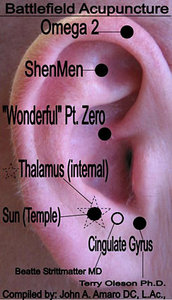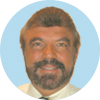It was recently announced that the U.S. Air Force will begin training physicians being deployed to Iraq and Afghanistan in a specific type of treatment. The treatment uses small needles in the skin of the ear to block pain in as few as five minutes and can last for several days or longer. The procedure was initially introduced in 2008 at Landstuhl Regional Medical Center (LRMC), where it was applied to wounded service members and local patients for pain relief, with significant results. The hospital, located near Ramstein Air Base in Germany, is the largest and most modern U.S. military medical facility outside the United States.
One of the pain specialists at LRMC personally experienced a 25 percent increased range of motion and a 50 percent reduction in pain for chronic shoulder and upper back pain he had endured for several years. As a result of his outstanding success, this pain specialist recruited his most challenging patients, for whom traditional pain treatment had offered limited relief. Within minutes of the needles being inserted, many said their pain was reduced by up to 75 percent. A 25 percent reduction would be considered a success with traditional pain medications.
Despite its name, battlefield acupuncture is not purposely designed to replace standard medical care for war-related injuries, but rather to assist in pain relief and in many cases eliminate the need for pain medication for acute and chronic pain. This procedure is extremely easy to learn and may be taught to anyone in an extremely short time. It allows a provider to confidently complete a treatment and expect a good result within minutes. There are virtually no complications and patients are subjected to little or no discomfort.
It has been reported that only approximately 15 percent of patients do not respond to this acupuncture procedure, but of those who do, their pain reduction often averages about 75 percent. The frequency of application and the duration of relief vary with each patient, but treatment can progress from about two times a week to as little as once a month or longer. In some cases, further acupuncture treatment may not be required.
There are five specific ear points that are classically used; however, many practitioners only use two. The five points are: Wonderful Point (also known as Point Zero), Shen Men, Omega 2, Thalamus and the Cingulate Gyrus. The Cingulate Gyrus point and the Thalamus are the two points all practitioners use.
 As in so many acupuncture procedures, practitioners may place the points in different locations. The Cingulate Gyrus has also been called the Subcortex by Terry Oleson, PhD (international authority on auriculotherapy). Beate Strittmatter, MD, a German authority, places it slightly differently (see Illustration). Personally, I use both locations just to make sure I cover all of my bases.
As in so many acupuncture procedures, practitioners may place the points in different locations. The Cingulate Gyrus has also been called the Subcortex by Terry Oleson, PhD (international authority on auriculotherapy). Beate Strittmatter, MD, a German authority, places it slightly differently (see Illustration). Personally, I use both locations just to make sure I cover all of my bases.
The Omega 2 point is on the internal of the helix. Due to the thinness of the auricle at this point, any stimulation from the exterior will contact the Omega 2 point. Some may wish to approach this point from the interior, but I personally go from the exterior.
The Thalamus point is directly opposite on the internal side of the exterior points known as the Temple or Sun. Most battlefield acupuncture practitioners approach the Thalamus from the internal position. However, I have always felt this point could be accessed just as easily by stimulation of the Temple (Sun) points from the exterior, and have used it that way for years.
The official procedure uses gold semi-permanent needles, which are placed directly into the point and left to fall out on their own in a day or two. I have seen marvelous results with low-level laser directly to the points, as well as electronic stimulation. Conventional acupuncture needles may be stimulated for 10 minutes. Then use an acu-patch, which is a small stimulation sphere attached by flesh-colored adhesive. This can be left in place for several days or longer.
This procedure is too valuable to overlook in your general practice. It is easy, quick and effective. Do not limit yourself to just acute or chronic pain with this combination of points. It is also extremely effective in anxiety, neurosis, neurasthenia and any psychological or stress-related issues.
Click here for previous articles by John Amaro, LAc, DC, Dipl. Ac.(NCCAOM), Dipl.Med.Ac.(IAMA).





